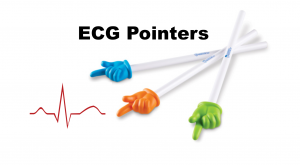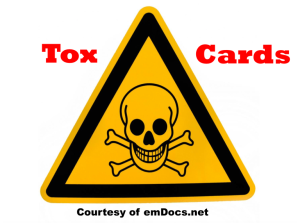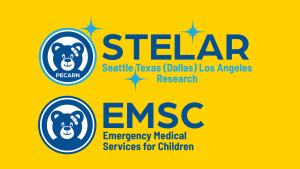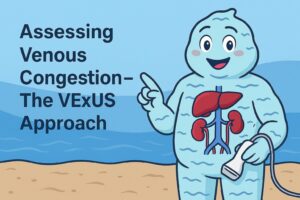Originally published at Pediatric EM Morsels on November 7, 2014. Reposted with permission.
Follow Dr. Sean M. Fox on twitter @PedEMMorsels
“Wheezing” is a prominent complaint in the Ped ED and it has been a frequent topic of the PedEM Morsels. We have covered a wide variety of Asthma management aspects: from initial therapies (MDIs vs Nebs) to potential hydration issues; from the utility ofMagnesium to the Heliox. We have also discussed more advanced topics likeNoninvasive Ventilation and how to Avoid Oxygen Desats as well as Delayed Sequence Intubation. While the goal is often to prevent intubation, occasionally, the only option is to use Mechanical Ventilation for your patient with Severe Asthma. The question, then, is how to make the best of a bad situation.
Important Pathophysiology
- There are several significant alterations that occur with acute, severe asthma exacerbations (Oddo, 2006).
- Heterogenous and reversible increased airway resistance
- Severe limitation of expiratory flow
- Premature airway closure
- Lung hyperinflation
- Decreased elastic recoil and increased FRC of up to 2 times normal and decreased
- Chest wall dynamic changes
- High intrinsic PEEP
- These produce clinically apparent:
- Respiratory fatigue
- Increased utilization of accessory muscles of respiration
- Ventilation/Perfusion Mismatch
- Very heterogenous areas of lung parenchyma with varying degrees of aeration
- Barotrauma
- High pulmonary pressures
- Hemodynamic instability
- Increased intrathoracic pressures negatively influencing the cardiac venous return/Preload and, hence, cardiac output.
- Respiratory fatigue
The Bad Situation: Needing to Intubate
- Fortunately, most often the patient with severe Status Asthmaticus can be managed without intubating.
- Recent population study found incidence of intubation for status asthmaticus was 0.55% (Sankeerth, 2014)
- Unfortunately, mechanical ventilation is associated with higher mortality.
- Indications for using Mechanical Ventilation for the patient with severe status asthmatics:
- This is a Clinical Decision!
- There is no lab value will define a need to intubate.
- Progressive exhaustion/fatigue with Altered Mental Status are the primary reasons.
- A cooperative patient, even if hypercapnic, may be managed with maximizing other therapies (see Noninvasive Ventilation andMagnesium).
- Hypoxia is usually not the sole reason to intubate, as supplemental oxygen typically corrects this; however, severe VQ mismatch can occur and be problematic. May require advanced techniques (see Delayed Sequence Intubation).
- There is a portion of patient who will present with Acute Asphyxial Asthma (Maffei 2004).
- These patients deteriorate rapidly and often require intubation upon arrival in the ED or within the first 30 minutes of management.
- Interestingly, these children have shorter durations of mechanical ventilation.
- Where you work plays a role (Shibata, 2014).
- Transport from a community ED to a tertiary center may be more problematic if the child is already tenuous.
- This is a Clinical Decision!
The Problem with Mechanical Ventilation
- Intubating a child should never be considered cavalierly, but after successfully placing the ETT, the real tricky part begins: not causing more harm with the mechanical ventilation process.
- Already the patient has severe hyperinflation, poor respiratory mechanics, and potential restricted preload.
- Complications of mechanical ventilation
- Hemodynamic instability following intubation.
- Hypotension occurs as a result of worsening hyperinflation leading to decreased cardiac preload.
- Cardiac Arrest can occur due to this progression as well.
- Barotrauma
- Pneumothorax
- Ventilator Associated Pneumonia
- Most common – accounting for ~10% of the complications (Sankeerth, 2014)
- Hemodynamic instability following intubation.
Making the Best of a Bad Situation
- If you have been placed between the rock and the hard place, and now must use mechanical ventilation, consider the following:
- Use a Cuffed Endotracheal Tube!
- Initial Ventilator Settings (Oddo, 2006):
- Mode: there is no evidence to support one mode over another. Many start with Volume-Control.
- Tidal Volume: 6-10 ml/kg ideal body weight
- Enough to move the chest.
- Expiratory Time: 4-5 seconds
- Inspiratory:Expiratory ratio may be 1:4, but can be as high as 1:8
- Goal is to allow exhalation and avoid stacking breathswith barotrauma.
- Resp Rate: Below physiologic rate for age.
- Controlled Hypoventilation has been shown to be safe (Dworkin, 1989)
- PEEP: zero (in acute phase. PEEP used once improving and weaning starts).
- FiO2: can start at 100%, but titrate to keep sats >90%.
- Keep the child adequately sedated!
- Avoid patient-ventilator asynchrony.
- Also helps decrease CO2 production.
- Ketamine is a useful med to consider!
- It is best to avoid prolonged neuromuscular paralysis if you are able to.
- Keep Plateau Pressures <30 cmH20
- Increased risk of barotrauma above this level.
- Measured by an end-inspiratory pause of several seconds in a system without leaks (hence, the cuffed ETT).
The Bad Situation Just Got Worse
- If, after initiation of mechanical ventilation, the patient become hemodynamically compromised:
- Step 1 – Disconnect from the Ventilator and allow the chest to recoil.
- If the hemodynamics improve, restart the mechanical ventilation at a lower tidal volume and respiratory rate.
- If the hemodynamics don’t improve… move to step 2.
- Step 2 – After you cry on the inside, consider typical complications.
- Dislodged ETT tube
- Using continuous End-Tidal CO2 Monitoring helps here!!
- Videoscopic Laryngoscope and or Ultrasound can help reconfirm as well.
- Obstructed ETT tube
- Suction the tube
- Pneumothorax
- Bedside Ultrasound is going to be faster and more sensitive than the portable CXR.
- Equipment Failure
- Because some days are just that kind of day.
- Dislodged ETT tube










4 thoughts on “Mechanical Ventilation for Severe Asthma”
And the clinical pearls just keep spilling out. Thanks for yet another great educational/entertaining start to my day. Could not agree more on the miracle drug known as ketamine. I know you were not trying to cover all of the topics related to the sick asthmatic, but we’ve had very good success as well with high flow, high humidity nasal cannula O2 on the scary wee ones.
Pingback: emDOCs.net – Emergency Medicine EducationEM@3AM - Acute Asthma Exacerbation - emDOCs.net - Emergency Medicine Education
Pingback: Conference Recap: Volume 2: Issue 6 08.09.18 – EMHouston.org
Pingback: Conference Recap: 08/09/18 – EMHouston.org